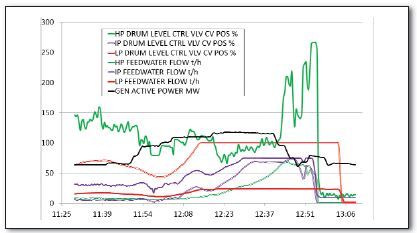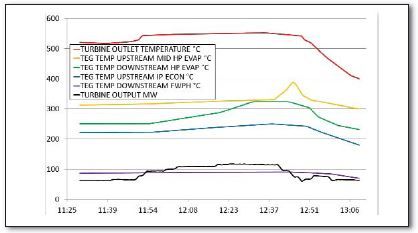Diagnosing A Combined Cycle Turbine Trip
OPERATIONAL DATA CAN BE USED TO BETTER UNDERSTAND AND RESOLVE DIFFICULT BOILER ISSUES
When trips occur in combustion turbines, one’s instinct is to focus on the area where the problem is occurring. This can be a trap. A better idea is to use combined cycle operational data, as this provides an overview of the system as a whole. For example, graphing operational data reveals trends that can identify the root cause of a problem, which can be far removed from its most visible symptom.
Consider the case of a site observing a low-water-level turbine trip in the lowpressure (LP) drum. Efforts to resolve LP drum issue alone would not have resolved the situation as the root cause turned out to be failed high-pressure (HP) drum level instrumentation.
This was the third time the combustion turbine tripped as the plant tried ramping up from 60% load. Just like previous trips, the water level in the LP steam drum slowly receded until it reached lower water cut out (LWCO). Site personnel confirmed that the level control valve was receiving a signal to open and that the actuator was in fact opening the valve. They removed the valve for inspection and scoped the feedwater line for obstructions. No issues found.

Figure 1: Feedwater flow and level control valve position vs. time[/caption]
Finding the cause
Without any clear cause for the low water level and subsequent turbine trips, operational data were reviewed from when the turbine began to ramp up to when it tripped. As the turbine ramped up, several observations were made:
- Low-pressure steam production increased 50%
- Intermediate-pressure steam production increased 150%
- High-pressure steam production steadily decreased.
Note too, that the high-pressure-level control valve was progressively opening, yet there was little corresponding increase in HP feedwater.
These points can be seen in Figure 1. Additionally, turbine exhaust gas temperature downstream of the HP boiler panels began to approach the temperature in the middle of the HP boiler panels (Figure 2), and the metal temperatures at the top of the HP drum began diverging from those at the bottom of the drum (Figure 3).

Figure 2: Turbine exhaust gas temperatures vs. time[/caption]

Figure 3: Drum shell temperatures vs. time[/caption]
For these observations to occur simultaneously with the turbine ramp, there would need to be a significant amount of heat bypassing the HP boiler panels, causing the downstream sections to absorb more heat than originally intended. An inspection confirmed that the baffling around the HP boiler panels was in place and that the fouling on those heat transfer surfaces was not out of the ordinary.
Another potential cause for the turbine exhaust gas passing through the HP evaporator panels without significantly dropping temperature would be if the HP drum and upper sections of the evaporator panels were dry (Figure 3).
Heat transfer between a tube surface and boiling water is nominally 100 times more effective than for slowmoving, dry steam. With heat transfer at the top of the HP evaporator so ineffective, there was significantly more heat being passed to, and absorbed by, the IP and LP system. This resulted in an increase in their respective steam flows, while adversely effecting the HP steam production.
The increase in temperature at the top of the drum compared to the bottom was caused by superheating of the dry steam in the top of the HP evaporator panels flowing through the drum and out the saturated steam line.
Feedwater into the drum was helping to keep the bottom of the drum cool. Gross steaming in the HP economizer caused a choked flow and prevented more water from entering the drum even with the level control valve continuing to open.
With operational data pointing to maintaining the HP drum level and a failure to trip, the level instrumentation was inspected. Of the three level indicators on the drum, one had experienced a failure several months prior and had been “valved” out. This led to an erroneously high instrument reading, but did not read as a default. The valved out instrument remained active in the turbine trip logic, which required two of the level indicators to call for a trip before the signal would be sent.
Of the two level indicators that remained in service, one began to develop a leak in its primary steam isolating valve, making it read artificially high, while the last remaining indicator operated normally. Even as the sole functional level indicator was showing the drum level below low-water cut out, the turbine was not tripped because neither of the other two failed indicators read below low water cut out.
This allowed the site to run with a dry HP drum and partially dry HP boiler panels. The intermediate pressure system, which is directly downstream of the HP system, absorbed more heat, and generated more steam than the LP system.
However, the feedwater pump and control valve had enough margin to handle the additional flow. The LP feedwater system was marginal and unable to keep up, eventually resulting in a turbine trip.
Lesson learned: instead of focusing only on the zone of the immediate problem, use operational data to look at the bigger picture. It will provide a more accurate analysis.